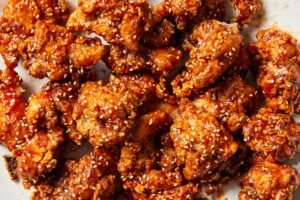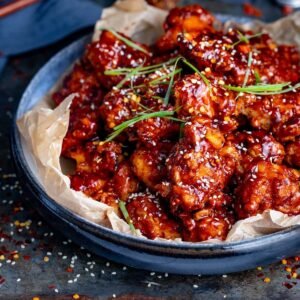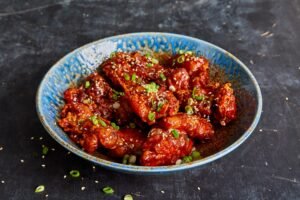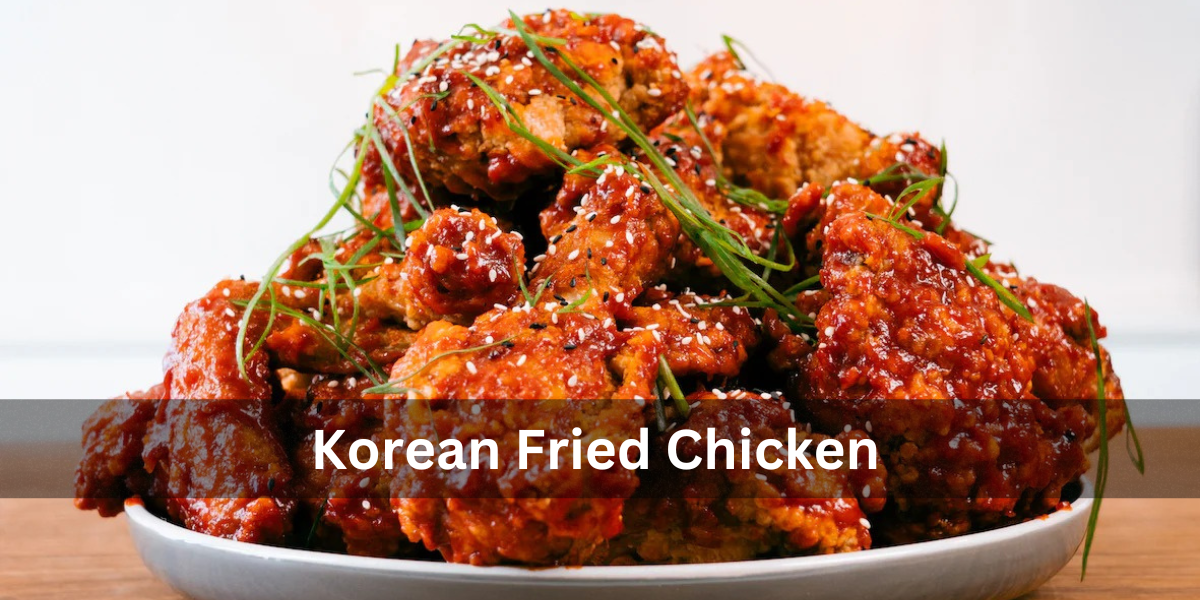I know you’re reading this because you enjoy Korean fried chicken. It’s a gourmet delight to bite through the well-seasoned, crispy crust to uncover succulent chicken beneath. This Korean fried chicken dish will provide you with that thin, crispy, and crunchy crust, as well as two wonderful sauce options: soy garlic and red spicy sauce!
Korean fried chicken, also known as “the other KFC,” is very popular both inside and outside of Korea. Over the last three or four decades, the Korean fried chicken sector has risen at an exponential rate. There are several fast food fried chicken businesses and mom-and-pop restaurants, each with their own techniques, secret ingredients, and variants.

Yangnyeom chicken is one of Korea’s most popular fried chicken varieties. Yangnyeom chicken, which translates as “seasoned chicken,” is fried chicken coated in fiery red sauce. Yangnyeom sauce has a broad variety of ingredients, including gochujang, ketchup, hot sauce, strawberry jam, and so on. It began out thick and heavy, but the current tendency is for a thinner, lighter sauce. Gyochon Chicken is Korea’s largest fried chicken chain, and Bonchon is the most well-known Korean fried chicken restaurant in the United States. Both are known for their thin, crackly crusts and two varieties of glazes: soy garlic and red spicy.
This Korean fried chicken recipe is based on Gyochon and Bonchon style fried chicken.
As indicated in my dakgangjeong recipe, another popular type, fried chicken, is typically enjoyed with beer, and this combination is called ChiMaek (치맥), chi from chicken (치킨) and maek from maekju (맥주, the Korean name for beer). It is a relatively new term that describes the casual dining and drinking lifestyle.
The chicken
For this recipe, I used chicken wings divided into drumettes and wingettes/flats, but any small cut(s) of chicken will suffice. In Korea, it is typical to slice up a little entire chicken for frying.
Korean Fried Chicken
In Korea, chicken is typically brined in a delicious solution for a day or two before cooking. I season the chicken with salt, pepper, and ginger. Allow it to remain in the fridge for at least 2 hours (or overnight to 24 hours) for the best results.
The batter
Dry or wet batter? In my last recipe, I just used potato starch (or cornstarch). It’s an easy approach to get a thin, crispy, and crunchy crust. You can still do this if you like, using 1/2 cup cornstarch or potato starch and thoroughly pressing it onto each chicken piece. It is a gluten-free choice. In the recipe card, I listed this as Batter Option 1.However, in Korea, fried chicken is typically made with wet batter. Some people just use frying mix (also known as tempura mix) to make wet batter, and there is even frying mix designed exclusively for chicken. Some people use a combination of frying mix and starch to provide extra crunch. Frying mix is normally seasoned and contains baking powder, so if you don’t have any, you can make it with all-purpose flour. I’ll include a note in the recipe card about how to adapt all-purpose flour for this recipe.

I experimented with numerous ratios and settled on a 2 to 1 frying mix to starch ratio, which is 1/2 cup frying mix and 1/4 cup potato starch (or cornstarch) in this recipe. When these dry ingredients are combined with equal parts water (3/4 cup), they form a delicately thin crust that is darker in color but lighter in texture than starch alone. You can use a bit extra water to make a thinner crust. Similarly, use less water to achieve a thicker crust. To achieve a thin crust, I do not dredge the chicken in the dry mixture before or after dipping it in the wet batter.
The crust holds up quite well to the sauce. Better better, the chicken remains crispy for several hours after being coated with sauce. Also, because the crust is gently seasoned from the frying mix, the fried chicken is wonderful even without sauce.
Fry the chicken.
To deep-fry wings, the Korean method often involves frying them at a low temperature (320-330°F) and then again at a higher temperature (350-360°F). Allow the chicken to cool for a few minutes in between so that any remaining liquid can escape. The initial frying can be completed ahead of time. For the first frying, divide the chicken into two batches; for the second frying, fried it all together.
The sauce
Korean fried chicken is typically served with two types of sauces: mild soy garlic and red hot, however they are sometimes referred to differently. You can select one or both to have ban/ban (half/half).
You can either toss or hand-brush the sauce onto the fried chicken pieces. The latter is what prominent chicken restaurants brag about doing to keep the crust crunchy longer. The brushing approach allows you to customize the amount of sauce on each piece.
Red hot sauce.
If you try this sweet and spicy red sauce, you’ll notice it’s significantly thinner and lighter than my original yangnyeom chicken sauce. It isn’t overly hot, but you can always tweak to your liking. I combine gochujang with hot sauce for a unique tangy flavor and intensity. If you don’t want to add any heat, use ketchup instead of hot sauce. If you’re not using hot sauce, mix in some vinegar (rice, white, or apple cider).
For sweetness, I use a combination of honey and sugar. You can substitute corn syrup or oligo syrup. Garlic is essential, however ginger can be used if preferred.
Soy Garlic Sauce
This soy sauce-based sauce is ideal for folks who do not enjoy spicy foods. Soy sauce, honey, and garlic are the main ingredients in this sauce, which forms a crispy translucent surface when glazed on chicken.
Ingredients
For the chicken:
- 2 pounds chicken wings (about 16 drumettes and wingettes)
- 1.5 teaspoons salt (use 1 ts if using table salt)
- pinch black pepper (or to taste)
- 1 teaspoon grated ginger
- 4-5 cups oil for frying about 2-inch deep (use deep, bottom heavy, medium size pot or pan)
For the dry batter option
- 1/2 cup potato starch (or cornstarch)
For the wet batter option

- 1/2 cup frying mix (aka tempura mix) or all-purpose flour with 1/2 teaspoon baking powder, 1/4 teaspoon salt, and optional 1/2 teaspoon garlic powder or onion powder.
- 1/4 cup potato starch (or cornstarch)
- 3/4 cup water
For the red spicy sauce (See note 1)
- 1 tablespoon soy sauce
- 2 tablespoons rice wine (or mirin) or other cooking wine
- 1 tablespoon or 1.5 tablespoons gochujang
- 1 tablespoon or 2 tablespoons hot sauce (sriracha, tabasco, Franks Original, etc.) You can use 2 Tbs ketchup instead along with a teaspoon vinegar, if you don’t want extra heat.
- 2 tablespoons sugar
- 2 tablespoons honey (or 2.5 tablespoons corn syrup, rice syrup, or oligo syrup)
- 1 tablespoon minced garlic
- 1/2 teaspoon honey dijon mustard – optional
- 4 tablespoons water
For the soy garlic sauce
- 2 tablespoons soy sauce
- 2 tablespoons rice wine (or mirin or other cooking wine)
- 2 tablespoons sugar
- 2 tablespoons honey (or 2.5 tablespoons corn syrup, rice syrup, or oligo syrup)
- 1 tablespoon minced garlic
- 1 teaspoon vinegar (white, rice, apple cider, etc.)
- 1 teaspoon or 2 teaspoons oyster sauce – optional
- 4 tablespoons water
For the optional garnish:

- 1/2 teaspoon sesame seeds
- 1 tablespoon chopped scallion
Instructions
-
Wash chicken wings, and drain thoroughly. Mix with the salt, pepper, and ginger. Let it sit in the fridge for 2 hours or longer (overnight to 24 hours).
-
Combine all the sauce ingredients of your choice and stir well. Boil over medium heat until it thickens slightly, about 4 to 5 minutes. Turn the heat off.
-
OPTION 1 Dry batter: If using the starch only, add the potato (or cornstarch) to the chicken, and rub it onto each wing well to coat evenly. Set aside.
-
OPTION 2 Wet batter: Mix the wet batter ingredients in a bowl, and stir well until smooth with no visible lumps.
-
Add the oil to a deep fryer, wok, or large pot. Heat the oil to 320°F (up to 330°F). Drop the chicken in the oil, one piece at a time. If using wet batter, dip each piece in the wet batter with tongs and shake off excess batter before dropping the chicken in the oil. Fry them in two batches. Cook until lightly golden, about 6 minutes, depending on the size of the chicken wings. Remove them with a wire skimmer or a slotted spoon. Drain on a wire rack or in a large mesh strainer set on a bowl.
-
Reheat the oil to 350°F (up to 360°F). Add the chicken (you can do this in one batch for the second frying), and deep fry again, for about 5 minutes, until golden brown. Drain on a wire rack or in a large mesh strainer set on a bowl.
-
You can either toss the fried chicken pieces in the sauce or hand-brush them. Sprinkle with the optional sesame seeds or chopped scallion to serve.
Notes
- 2 tablespoons grated onion
- 1 tablespoon minced garlic
- 1 teaspoon finely grated ginger
- 1 tablespoon soy sauce
- 4 tablespoons rice wine (or mirin)
- 2 – 3 tablespoons hot sauce (I used Frank’s Original)
- 4 tablespoons chili sauce or ketchup
- 2 tablespoons gochujang
- 2 tablespoons corn syrup or honey
- 1 tablespoon sugar
- 1 teaspoon sesame oil
Add 1 tablespoon of cooking oil and then the onion, garlic, and ginger. Stir for a minute until fragrant. Add all other sauce ingredients, and stir well. Simmer until it thickens slightly, about 4 to 5 minutes. Turn the heat off. The sauce will get slightly thicker as it cools down.
If you want to make the red spicy sauce even more spicy, add 1/2 teaspoon (or to taste) of gochugaru (Korean red chili pepper flakes) or drop in a couple of small dried red chili peppers.
FAQ:
What makes Korean Fried Chicken different from other fried chicken?
Korean Fried Chicken (KFC) is typically double-fried, resulting in an extra crispy exterior while keeping the meat juicy and tender inside. It’s also known for its unique sauce varieties, which range from spicy to sweet and savory.
What are some popular Korean Fried Chicken sauces?
Some popular sauces include spicy gochujang (Korean chili paste) sauce, soy garlic sauce, honey butter sauce, and sweet and sour sauce. These sauces can vary in heat level and flavor profile, catering to different preferences.
Is Korean Fried Chicken spicy?
It can be, depending on the sauce used. Some varieties, like those with gochujang-based sauces, can be quite spicy, while others, like soy garlic or honey butter, are milder.
What side dishes typically accompany Korean Fried Chicken?
Common side dishes include pickled radishes (danmuji), coleslaw, kimchi, and pickled cucumbers. These side dishes provide a balance of flavors and textures to complement the crispy chicken.
Can Korean Fried Chicken be made at home?
Yes, Korean Fried Chicken can be made at home. While it requires double-frying for the crispy texture, it’s relatively simple to make, and there are many recipes available online for homemade versions.
What type of oil is best for frying Korean Fried Chicken?
Peanut oil or vegetable oil are commonly used for frying Korean Fried Chicken due to their high smoke points and neutral flavors, which won’t overpower the taste of the chicken or the sauce.
How do you keep Korean Fried Chicken crispy?
To keep Korean Fried Chicken crispy, it’s important to drain excess oil properly after frying and to serve it immediately after tossing it in the sauce. Reheating in an oven can help crisp it up again if necessary.
Is Korean Fried Chicken gluten-free?
It depends on the recipe and the sauce used. Traditional Korean Fried Chicken recipes often use wheat flour for coating, so they are not gluten-free. However, gluten-free alternatives can be used for coating, and gluten-free sauces can be made or purchased to accommodate dietary restrictions.
